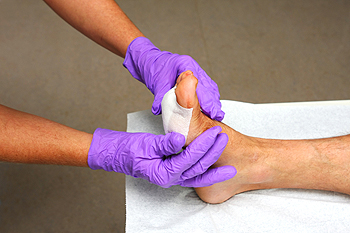
People with diabetes mellitus face a higher risk of foot wounds that are slow to heal due to poor circulation and nerve damage, which can slow the body’s natural healing process. One treatment used by some podiatrists is negative pressure wound therapy. This method involves placing a special dressing over the wound and connecting it to a gentle suction pump. The controlled suction removes excess fluids and helps draw healthy tissue toward the wound to promote faster healing. Negative pressure wound therapy also reduces swelling and lowers the risk of infection. By keeping the wound cleaner and improving blood flow, this treatment encourages the body to repair damaged tissue more effectively. Some patients find that using this therapy helps their wounds heal more quickly than with standard treatments alone. If you have a diabetic foot wound that is not improving, it is suggested you schedule a visit with a podiatrist to explore your treatment options.
Wound care is an important part in dealing with diabetes. If you have diabetes and a foot wound or would like more information about wound care for diabetics, consult with Tanya R. Sellers-Hannibal, DPM from Maryland. Our doctor will assess your condition and provide you with quality foot and ankle treatment.
What Is Wound Care?
Wound care is the practice of taking proper care of a wound. This can range from the smallest to the largest of wounds. While everyone can benefit from proper wound care, it is much more important for diabetics. Diabetics often suffer from poor blood circulation which causes wounds to heal much slower than they would in a non-diabetic.
What Is the Importance of Wound Care?
While it may not seem apparent with small ulcers on the foot, for diabetics, any size ulcer can become infected. Diabetics often also suffer from neuropathy, or nerve loss. This means they might not even feel when they have an ulcer on their foot. If the wound becomes severely infected, amputation may be necessary. Therefore, it is of the upmost importance to properly care for any and all foot wounds.
How to Care for Wounds
The best way to care for foot wounds is to prevent them. For diabetics, this means daily inspections of the feet for any signs of abnormalities or ulcers. It is also recommended to see a podiatrist several times a year for a foot inspection. If you do have an ulcer, run the wound under water to clear dirt from the wound; then apply antibiotic ointment to the wound and cover with a bandage. Bandages should be changed daily and keeping pressure off the wound is smart. It is advised to see a podiatrist, who can keep an eye on it.
If you have any questions, please feel free to contact our office located in Owings Mills, MD . We offer the newest diagnostic and treatment technologies for all your foot care needs.
